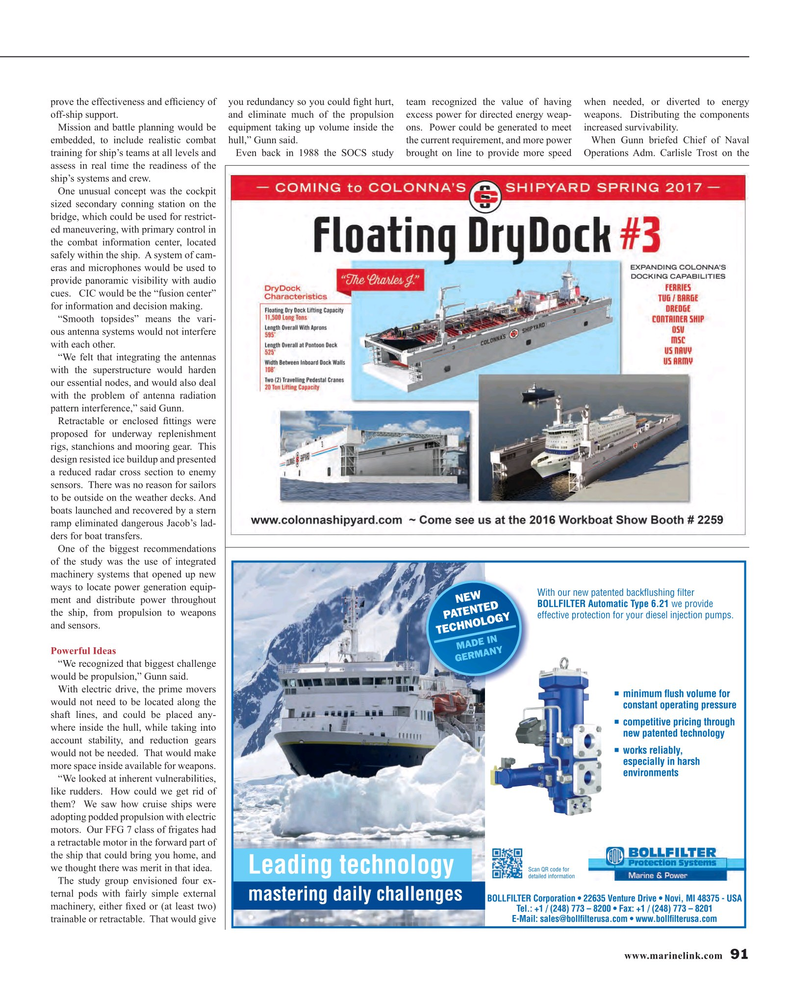
Page 91: of Maritime Reporter Magazine (November 2016)
Workboat Edition
Read this page in Pdf, Flash or Html5 edition of November 2016 Maritime Reporter Magazine
prove the effectiveness and ef? ciency of you redundancy so you could ? ght hurt, team recognized the value of having when needed, or diverted to energy off-ship support. and eliminate much of the propulsion excess power for directed energy weap- weapons. Distributing the components
Mission and battle planning would be equipment taking up volume inside the ons. Power could be generated to meet increased survivability.
embedded, to include realistic combat hull,” Gunn said. the current requirement, and more power When Gunn briefed Chief of Naval training for ship’s teams at all levels and Even back in 1988 the SOCS study brought on line to provide more speed Operations Adm. Carlisle Trost on the assess in real time the readiness of the ship’s systems and crew.
One unusual concept was the cockpit sized secondary conning station on the bridge, which could be used for restrict- ed maneuvering, with primary control in the combat information center, located safely within the ship. A system of cam- eras and microphones would be used to provide panoramic visibility with audio cues. CIC would be the “fusion center” for information and decision making.
“Smooth topsides” means the vari- ous antenna systems would not interfere with each other. “We felt that integrating the antennas with the superstructure would harden our essential nodes, and would also deal with the problem of antenna radiation pattern interference,” said Gunn.
Retractable or enclosed ? ttings were proposed for underway replenishment rigs, stanchions and mooring gear. This design resisted ice buildup and presented a reduced radar cross section to enemy sensors. There was no reason for sailors to be outside on the weather decks. And boats launched and recovered by a stern ramp eliminated dangerous Jacob’s lad- ders for boat transfers.
One of the biggest recommendations of the study was the use of integrated machinery systems that opened up new ways to locate power generation equip-
With our new patented back? ushing ? lter ment and distribute power throughout
NEW
BOLLFILTER Automatic Type 6.21 we provide the ship, from propulsion to weapons effective protection for your diesel injection pumps.
PATENTED and sensors.
TECHNOLOGY
MADE IN
Powerful Ideas
GERMANY “We recognized that biggest challenge would be propulsion,” Gunn said.
With electric drive, the prime movers ? minimum ? ush volume for would not need to be located along the constant operating pressure shaft lines, and could be placed any- ? competitive pricing through where inside the hull, while taking into new patented technology account stability, and reduction gears ? works reliably, would not be needed. That would make especially in harsh more space inside available for weapons.
environments “We looked at inherent vulnerabilities, like rudders. How could we get rid of them? We saw how cruise ships were adopting podded propulsion with electric motors. Our FFG 7 class of frigates had a retractable motor in the forward part of the ship that could bring you home, and we thought there was merit in that idea.
Scan QR code for
Leading technology detailed information
The study group envisioned four ex- ternal pods with fairly simple external mastering daily challenges "/,,&),4%2

 90
90

 92
92
